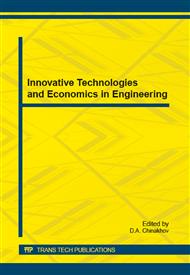[1]
A.I. Gusev, Nanomaterials, nanostructures, nanotechnologies, FIZMATLIT, Moscow, (2005).
Google Scholar
[2]
N.A. Yavorovski, Production of ultrafine powders by electric explosion method, Russian Physics Journal. 4 (1996) 114-136.
Google Scholar
[3]
S.P. Zhuravkov, E.V. Plotnikov, D.V. Martemianov, N.A. Yavorovski, U. Xasse, S. Zander, Study of properties of silver nanosized particles produced by electric pulse method, Russian Physics Journal. 56, No. 7/2 (2013) 141-145.
Google Scholar
[4]
S. Tarasov, A. Kolubaev, S. Belyaev, M. Lerner, F. Tepper, Study of friction by nanocopper additives to motor oil, Wear. 252 (2002) 63-69.
DOI: 10.1016/s0043-1648(01)00860-2
Google Scholar
[5]
A.V. Vosmerikov, A.E. Ermakov, L.N. Vosmerikova, T.A. Fedushchak, G.V. Ivanov, Conversion of lower alkanes in presence of metal nanoparticles deposited on zeolite matrix, Kinetics and catalysis. 45, No. 2 (2004) 232-236.
DOI: 10.1023/b:kica.0000023794.14385.36
Google Scholar
[6]
P.K. Dash and Y. Balto, Generation of Nano-copper Particles through Wire Explosion Method and its Characterization, Research Journal of Nanoscience and Nanotechnology 1.
DOI: 10.3923/rjnn.2011.25.33
Google Scholar
[1]
25-33, Malaysia, (2011).
Google Scholar
[7]
Yu.A. Kotov, N.A. Yavorovski, Study of particles formed after electric explosion of wires, Physics and chemistry of materials processing. 4 (1978) 24-29.
Google Scholar


